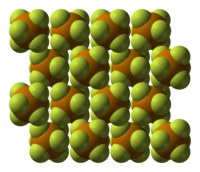This is an old revision of this page, as edited by FoxBot (talk | contribs) at 18:03, 3 January 2011 (robot Adding: nl:Telluurhexafluoride). The present address (URL) is a permanent link to this revision, which may differ significantly from the current revision.
Revision as of 18:03, 3 January 2011 by FoxBot (talk | contribs) (robot Adding: nl:Telluurhexafluoride)(diff) ← Previous revision | Latest revision (diff) | Newer revision → (diff)
| |||
| Identifiers | |||
|---|---|---|---|
| CAS Number | |||
| 3D model (JSmol) | |||
| ECHA InfoCard | 100.029.115 | ||
| PubChem CID | |||
| CompTox Dashboard (EPA) | |||
SMILES
| |||
| Properties | |||
| Chemical formula | TeF6 | ||
| Molar mass | 241.59 g/mol | ||
| Density | 0.0106 g/cm³ | ||
| Melting point | −38.9 °C | ||
| Boiling point | −37.6 °C | ||
| Structure | |||
| Crystal structure | Orthorhombic, oP28 | ||
| Space group | Pnma, No. 62 | ||
| Coordination geometry | octahedral (Oh) | ||
| Dipole moment | 0 | ||
| Except where otherwise noted, data are given for materials in their standard state (at 25 °C , 100 kPa). Infobox references | |||
Tellurium hexafluoride is the oldest known fluoride of tellurium. It is a colorless, highly toxic gas with an extremely unpleasant smell.
Preparation
Tellurium hexafluoride is most commonly prepared by passing fluorine gas over tellurium metal at 150 °C. Below this temperature a mixture of lower fluorides form, including tellurium tetrafluoride and ditellurium decafluoride. It can also be prepared by passing fluorine gas over TeO3 or indirectly by reacting TeO2 with SeF4 to produce TeF4 and then heating TeF4 in excess of 200 °C to make TeF6 and Te.
Properties
Tellurium hexafluoride is a highly symmetric octahedral molecule. Its physical properties resemble the sulfur and selenium analogs. It is less volatile, however, due to the increase in molecular weight. At temperatures below −38 °C, tellurium hexafluoride condenses to a volatile white solid.


Reactivity
Unlike the sulfur analog, tellurium hexafluoride is not chemically inert. This can be attributed to the greater availability of the d orbitals and perhaps the availability of the f orbitals which neither sulfur or selenium have access to. TeF6 is hydrolyzed in water to H6TeO6 and reacts with Te below 200 °C.
Health Hazards
People exposed to tellurium compounds exhibit "tellurium breath", which has a garlic-like odour. This garlic odour is also present in sweat and urine. Other symptoms of tellurium exposure include headache, dyspnea, weakness, bluish-black markings on fingers, neck, face and gums, metallic taste in the mouth and skin rash. Death may occur from pulmonary edema. People exposed to tellurium compounds should be removed from the area and seek medical attention.
References
- ^ CRC Handbook of Chemistry and Physics, 90. Auflage, CRC Press, Boca Raton, Florida, 2009, ISBN 978-1-4200-9084-0, Section 4, Physical Constants of Inorganic Compounds, p. 4-95.
Literature
- W.C. Cooper; Tellurium, Van Nostrand Reinhold Company, New York, USA, 1971.
- K.W. Bagnall; The Chemistry of Selenium, Tellurium and Polonium, Elsevier Publishing, New York, 1966.
- R.T. Sanderson; Chemical Periodicity, Reinhold, New York, USA, 1960.
- N.N. Greenwood and A. Earnshaw; Chemistry of the Elements, 2nd edition, Butterworth, UK, 1997.
- F.A. Cotton, G. Wilkinson, C.A. Murillo, and M. Bochmann; Advanced Inorganic Chemistry, John Wiley & Sons, 1999.
- G.J. Hathaway, N.H. Proctor; Chemical Hazards of the Workplace, 5th edition, Wiley-Interscience, New Jersey, 2004.
External links
| Tellurium compounds | |
|---|---|

